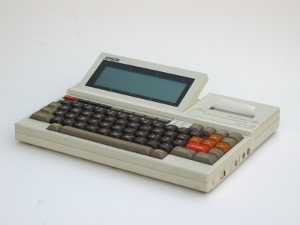Epson PX-4

It was targeted as successor of the Epson HX-20 portable, which was very popular with field engineers.
Another feature of the PX-4 was its high modularity. Inheriting the ROM capsules from the Epson PX-8 Geneva, it added a cartridge bay (similar but incompatible with the Epson HX-20), for which Epson offered several printers, micro-cassette drive, modem, EPROM writer, DMM (Digital Multimeter Module), RAM and ROM cartridges.[2] Third parties could make custom cartridges. The modem, EPROM writer and DMM needed user programs. The system allowed for BIOS extensions (User BIOS). Other features were the Serial and RS232 port, barcode reader interface like with the Epson PX-8 Geneva. New were a cassette port and parallel printer port.
The keyboard was also easy replaceble, allowing country specific layouts but also custom layouts, like the 'item keyboard' turning the PX-4 into a cash register. This trend was taken further by the Epson PX-16 for which even 'item keyboards' with touch screens were available.
Internal RAM was 64K, of which a part could be reserved as RAM disk. An External RAM disk could be attached, creating a 120K RAM disk, leaving internal RAM as user BIOS and workspace.
The PX-4+ was an improved version which had the External RAM disk integrated.
Notes
External links
Literature
- PX-4 / HX-40 Operating System Reference Manual, EPSON, 1985. Y20699101600
- PX-4 DISK UTILITIES OPERATING MANUAL, EPSON, 1984. H8592003-0 / Y322990003
- PX-4 BASIC REFERENCE MANUAL,EPSON, 1985. Y200599100601
- PX-4 OPERATING MANUAL EPSON 1985. H8592005-1 / Y205991005